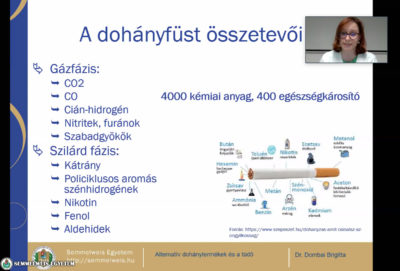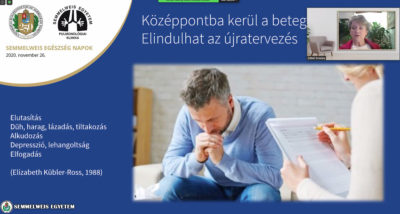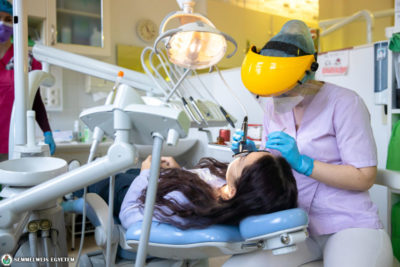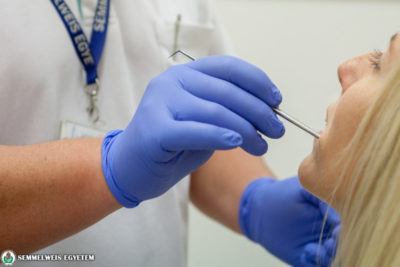The online event of Semmelweis Health Days, organized by the Department of Pulmonology on November 26 was focusing on the harmful effects of smoking, asthma, allergies, coronavirus, malignant lung cancer as well as the emotional support provided to patients with cancer. Based on the preliminary registrations, more than 2,200 people registered for the nine presentations held by the department, out of which three were already full prior to the end of the deadline of online registration.
“In the course of the program series of Semmelweis Health Days, we aimed at demonstrating the most important pulmonary diseases, their diagnostics and therapies. Besides malignant lung cancer, asthma and Chronic Obstructive Pulmonary Disease (COPD), we cannot omit coronavirus from the list, which has particular relevance these days”, emphasized Dr. Veronika Müller, professor, head of the Department of Pulmonology.
The organizers aimed at creating interactive presentations even in the framework of the online event, thus they provided opportunity for consultations at the end of each presentation – the professor highlighted.
 Dr. Brigitta Dombai, resident started her presentation with a short historic outlook, and besides smoking, she also talked about the harmful and tumour-inducing effects of alternative tobacco products, especially focusing on hookah and e-cigarette. Even if hookah smoking is an occasional community program, but the rate of becoming cigarette smokers in the end is eight times more frequent for those young people who try hookah. According to the presentation, there are 4,000 chemical substance present in cigarette smoke, of which one tenth are proven to have harmful effects on health and these can be equally found in alternative tobacco products as well. For example nicotine is one of them, which is known for rising the blood pressure, as well as for its cardio-vascular, tumour-inducing and embryotoxic effects. Even though the statistics related to smoking in Hungary have improved during the recent past years, but it is important to know that those people who smoke more than 10 cigarettes a day, may live 5-10 years less as opposed to non-smokers – pointed out Dr. Dombai.
Dr. Brigitta Dombai, resident started her presentation with a short historic outlook, and besides smoking, she also talked about the harmful and tumour-inducing effects of alternative tobacco products, especially focusing on hookah and e-cigarette. Even if hookah smoking is an occasional community program, but the rate of becoming cigarette smokers in the end is eight times more frequent for those young people who try hookah. According to the presentation, there are 4,000 chemical substance present in cigarette smoke, of which one tenth are proven to have harmful effects on health and these can be equally found in alternative tobacco products as well. For example nicotine is one of them, which is known for rising the blood pressure, as well as for its cardio-vascular, tumour-inducing and embryotoxic effects. Even though the statistics related to smoking in Hungary have improved during the recent past years, but it is important to know that those people who smoke more than 10 cigarettes a day, may live 5-10 years less as opposed to non-smokers – pointed out Dr. Dombai.
Dr. György Losonczy, professor talked about malignant lung cancer and its new treatment opportunities in his presentation. He highlighted that smoking is the most common cause of malignant lung cancer and he demonstrated in pictures how the healthy bronchial epithelium transforms into a tumorous bronchial epithelium. Professor Losonczy also talked about the most frequent symptoms of malignant lung cancer (such as coughing, dyspnea, weight loss, loss of appetite), which are non-specific and do not cause pain, therefore the disease is detected only at a later stage. This leads to the fact that 70% of the cases are diagnosed at an advanced stage of the disease. Beyond chemotherapy, which has several side effects, there are two therapies with the help of which the deadly disease may be ‘tamed’ into a chronic disease: molecular targeted therapy has been available since 2008 in the treatment of metastatic lung cancer, and immunotherapy has been a treatment opportunity since 2017 – the professor of oncology and pulmonology emphasized.
 In her presentation, Dr. Orsolya Gőbel, psychologist provided support for the relatives of patients with cancer in how to help well in such a difficult situation. She talked about the phases of the disease in details: in the course of the disease first there is refusal in the patient, then comes fury, anger, rebellion, protest, bargaining, depression, gloom and finally acceptance. It is very important for the person concerned to make new plans in his/her life, and for the surrounding family members to understand that the patient needs our help to be able to help himself/herself. In the course of the fight with the disease, only 50% is the medical treatment, the remaining 50% can be added by the patient himself/herself. For the exceptionally challenging difficulties of the last period, she advised the following: this is the time for the phrasing of the unspoken words, the tears, opening up in front of each other, expressing gratitude and thankfulness.
In her presentation, Dr. Orsolya Gőbel, psychologist provided support for the relatives of patients with cancer in how to help well in such a difficult situation. She talked about the phases of the disease in details: in the course of the disease first there is refusal in the patient, then comes fury, anger, rebellion, protest, bargaining, depression, gloom and finally acceptance. It is very important for the person concerned to make new plans in his/her life, and for the surrounding family members to understand that the patient needs our help to be able to help himself/herself. In the course of the fight with the disease, only 50% is the medical treatment, the remaining 50% can be added by the patient himself/herself. For the exceptionally challenging difficulties of the last period, she advised the following: this is the time for the phrasing of the unspoken words, the tears, opening up in front of each other, expressing gratitude and thankfulness.
Dr. Tamás Erdélyi, resident presented useful information about allergies. The unpleasant symptoms are most commonly caused by pollen, but many people are allergic to dog or cat hair, or even to an insect. In the course of an allergy caused by animal hair it is not the hair that triggers an unpleasant reaction, but such protein, which spreads with the animal’s detached epithelial cells, saliva and urine, while in the case of dust mite, the insect’s feces is the main allergen.
The presentation providing support for asthmatic patients was compiled by Dr. Lilla Tamási professor, and was held by Lilla Koch 6th year university student. She elaborated on the typical symptoms of the disease and the steps of the examination. Providing a diagnosis referring to asthma can be done by a pulmonologist based on pulmonary function tests in the case of typical symptoms – said she. She also mentioned that the disease may be related to an allergenic factor. She reassured those who are concerned: the examination is painless.
Dr. Anikó Bohács, associate professor presented the inhalation therapies, which represent the basics for treatments of obstructive pulmonary diseases (asthma, COPD). Inhalation therapies have significantly fewer side effects as opposed to a treatment when these were used in the form of tablets for oral administration. In case of certain diseases, antibiotics and cough syrup can also be applied in inhalation, however the inhalation of irritant preparations may be harmful for the respiratory track – said she.
 In her presentation focusing on the role of Semmelweis University, Dr. Veronika Müller, professor, head of the Department of Pulmonology talked about the emergence of COVID-19 disease in Hungary and about its symptoms. She highlighted that COVID-19 patient care is multidisciplinary, in which the medical doctors and health care personnel of several professions participate. Dr. Müller presented a short film as well, with which she aimed at illustrating the significance of the work performed by the participants of COVID-19 patient care, starting from the cleaning personnel to physiotherapists. The event participants had the opportunity to see how the medical staff put on their protective clothing before entering the red zone, and how disinfection is performed after the exit from the zone. Professor Müller also talked about the available therapeutic opportunities, namely remdesivir and favipiravir, and she emphasized that these are applied at the department with caution. Furthermore, she provided useful advice about what to do when someone is infected and has to stay at home. For example, it is important to drink a lot of liquid, to rest, to take vitamins, and to reduce the temperature if necessary. In case of general emergency symptoms (such as deteriorating dyspnea, impaired vision, speech disorder, chest pain, persistent vomiting), the patient’s hospitalization may be required. According to Dr. Müller, while in quarantine, breathing gymnastics are recommended instead of doing very intensive physical activities. The feeling of fatigue may remain for a significant period of time in the case of 53% of those patients who encountered with the infection, even after the disease is already over – said she.
In her presentation focusing on the role of Semmelweis University, Dr. Veronika Müller, professor, head of the Department of Pulmonology talked about the emergence of COVID-19 disease in Hungary and about its symptoms. She highlighted that COVID-19 patient care is multidisciplinary, in which the medical doctors and health care personnel of several professions participate. Dr. Müller presented a short film as well, with which she aimed at illustrating the significance of the work performed by the participants of COVID-19 patient care, starting from the cleaning personnel to physiotherapists. The event participants had the opportunity to see how the medical staff put on their protective clothing before entering the red zone, and how disinfection is performed after the exit from the zone. Professor Müller also talked about the available therapeutic opportunities, namely remdesivir and favipiravir, and she emphasized that these are applied at the department with caution. Furthermore, she provided useful advice about what to do when someone is infected and has to stay at home. For example, it is important to drink a lot of liquid, to rest, to take vitamins, and to reduce the temperature if necessary. In case of general emergency symptoms (such as deteriorating dyspnea, impaired vision, speech disorder, chest pain, persistent vomiting), the patient’s hospitalization may be required. According to Dr. Müller, while in quarantine, breathing gymnastics are recommended instead of doing very intensive physical activities. The feeling of fatigue may remain for a significant period of time in the case of 53% of those patients who encountered with the infection, even after the disease is already over – said she.
Dr. Lilla Büdi, resident talked about the history, types and significance of vaccination. In her presentation she emphasized that vaccinations save the lives of 2-3 million people worldwide every year. In Hungary, the vaccination coverage related to children’s mandatory vaccinations is 98%, which is considered to be outstanding. She highlighted the flu vaccination out of the vaccinations related to respiratory infections: it is recommended for everyone, since the course of the disease can be alleviated with this and the complications can be prevented. As regards the vaccination for COVID-19, she informed the participants that currently there are 48 clinical trials in progress, and the vaccination may be available in the first half of the year 2021.
The closing presentation of the program was held by Dr. Gyöngyi Csósza, cardiologist, during which she presented the causes and treatment of exercise-induced shortness of breath. Since this symptom can be caused by several different diseases, this makes the diagnostic process harder – said she. Beyond respiratory disorders, circulatory problems and other diseases such as anemia or thyroid problems can be in the background. The symptom is not always caused by a disease: exercise-induced shortness of breath can emerge in case of a larger physical activity, at higher altitudes and in case of obesity – pointed out Dr. Csósza. She mentioned a rare disease, called pulmonary hypertension, which mostly affects young people: it is a disease when there is an anomaly in the pulmonary vessels and this leads to a shortness of breath. The therapy focuses on the treatment of the underlying disease and the amelioration of condition, in case there is no contraindication.
The Semmelweis Health Days program series will presumably be continued in 2021 February.
Orsolya Dávid
Photo: Attila Kovács – Semmelweis University
Translation: Katalin Illés-Romhányi


